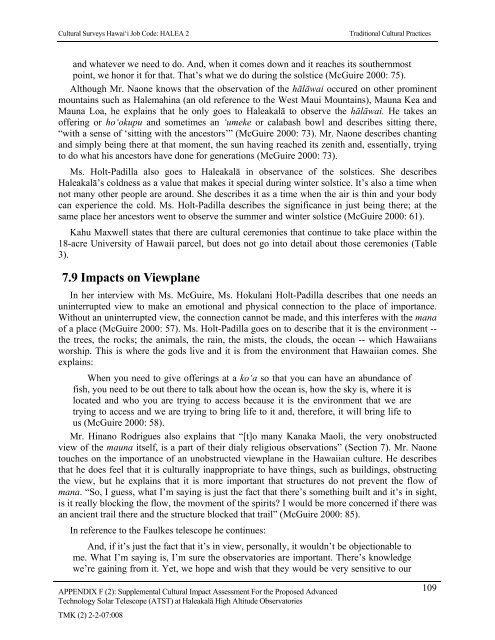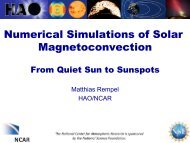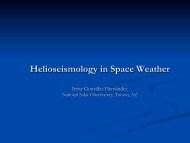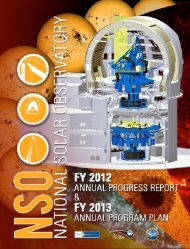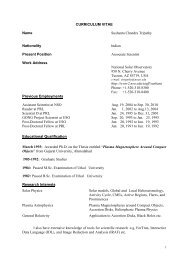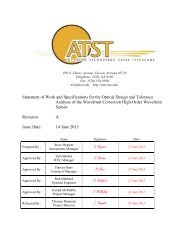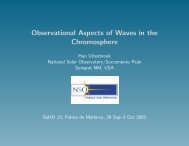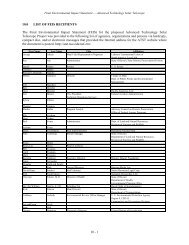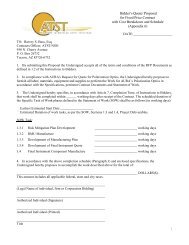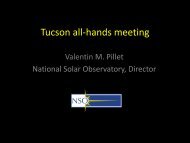F2 - ATST
F2 - ATST
F2 - ATST
Create successful ePaper yourself
Turn your PDF publications into a flip-book with our unique Google optimized e-Paper software.
Cultural Surveys Hawai‘i Job Code: HALEA 2Traditional Cultural Practicesand whatever we need to do. And, when it comes down and it reaches its southernmostpoint, we honor it for that. That’s what we do during the solstice (McGuire 2000: 75).Although Mr. Naone knows that the observation of the hālāwai occured on other prominentmountains such as Halemahina (an old reference to the West Maui Mountains), Mauna Kea andMauna Loa, he explains that he only goes to Haleakalā to observe the hālāwai. He takes anoffering or ho‘okupu and sometimes an ‘umeke or calabash bowl and describes sitting there,“with a sense of ‘sitting with the ancestors’” (McGuire 2000: 73). Mr. Naone describes chantingand simply being there at that moment, the sun having reached its zenith and, essentially, tryingto do what his ancestors have done for generations (McGuire 2000: 73).Ms. Holt-Padilla also goes to Haleakalā in observance of the solstices. She describesHaleakalā’s coldness as a value that makes it special during winter solstice. It’s also a time whennot many other people are around. She describes it as a time when the air is thin and your bodycan experience the cold. Ms. Holt-Padilla describes the significance in just being there; at thesame place her ancestors went to observe the summer and winter solstice (McGuire 2000: 61).Kahu Maxwell states that there are cultural ceremonies that continue to take place within the18-acre University of Hawaii parcel, but does not go into detail about those ceremonies (Table3).7.9 Impacts on ViewplaneIn her interview with Ms. McGuire, Ms. Hokulani Holt-Padilla describes that one needs anuninterrupted view to make an emotional and physical connection to the place of importance.Without an uninterrupted view, the connection cannot be made, and this interferes with the manaof a place (McGuire 2000: 57). Ms. Holt-Padilla goes on to describe that it is the environment --the trees, the rocks; the animals, the rain, the mists, the clouds, the ocean -- which Hawaiiansworship. This is where the gods live and it is from the environment that Hawaiian comes. Sheexplains:When you need to give offerings at a ko‘a so that you can have an abundance offish, you need to be out there to talk about how the ocean is, how the sky is, where it islocated and who you are trying to access because it is the environment that we aretrying to access and we are trying to bring life to it and, therefore, it will bring life tous (McGuire 2000: 58).Mr. Hinano Rodrigues also explains that “[t]o many Kanaka Maoli, the very onobstructedview of the mauna itself, is a part of their dialy religious observations” (Section 7). Mr. Naonetouches on the importance of an unobstructed viewplane in the Hawaiian culture. He describesthat he does feel that it is culturally inappropriate to have things, such as buildings, obstructingthe view, but he explains that it is more important that structures do not prevent the flow ofmana. “So, I guess, what I’m saying is just the fact that there’s something built and it’s in sight,is it really blocking the flow, the movment of the spirits? I would be more concerned if there wasan ancient trail there and the structure blocked that trail” (McGuire 2000: 85).In reference to the Faulkes telescope he continues:And, if it’s just the fact that it’s in view, personally, it wouldn’t be objectionable tome. What I’m saying is, I’m sure the observatories are important. There’s knowledgewe’re gaining from it. Yet, we hope and wish that they would be very sensitive to ourAPPENDIX F (2): Supplemental Cultural Impact Assessment For the Proposed AdvancedTechnology Solar Telescope (<strong>ATST</strong>) at Haleakalā High Altitude ObservatoriesTMK (2) 2-2-07:008109


